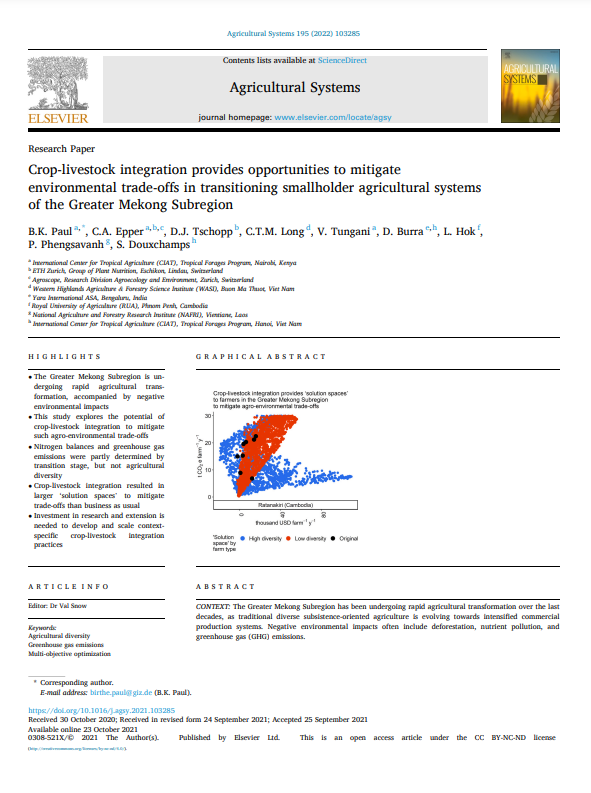CONTEXT: The Greater Mekong Subregion has been undergoing rapid agricultural transformation over the last decades, as traditional diverse subsistence-oriented agriculture is evolving towards intensified commercial production systems. Negative environmental impacts often include deforestation, nutrient pollution, and greenhouse gas (GHG) emissions.
OBJECTIVE: This study aims to explore the potential of crop-livestock integration to mitigate trade-offs between economic and environmental impacts of smallholder farming systems at different stages of agricultural transition and degrees of agricultural diversity across the Greater Mekong Subregion.
METHODS: We chose a ‘middle ground’ between detailed modeling of few, representative farming systems and modeling of large household populations. 24 low and high diversity farms were selected in Laos (Xieng Khouang province), Cambodia (Ratanakiri province) and Vietnam (Central Highlands) from a survey dataset of 1300 households. These farming systems were simulated with the whole-farm bio-economic and multi-objective optimization model FarmDESIGN, calculating operating profit, GHG emissions and nitrogen (N) balance. Two optimizations (‘business as usual’ vs. ‘crop-livestock integration’) were performed, generating ‘solution spaces’ or alternative configurations aiming to maximize profitability, keep farm N balanced and minimize GHG emissions.
RESULTS AND CONCLUSIONS: Agricultural systems across the sites differed in their production orientation and management practices, representing various stages of agricultural transition. Nitrogen balances varied between sites, being negative in Ratanakiri (average 20.5 kg N ha 1 y 1) and Xieng Khouang ( 36.5 kg N ha 1 y 1) and positive in the Central Highlands (73 kg N ha 1 y 1). Negative balances point to unsustainable mining of nutrients due to sale of cash crops without sufficient inputs, and positive balances to the risk of environmental contamination. Total GHG emissions ranged from 0.52–8.12 t CO2e ha 1 and were not significantly impacted by stage of agricultural transformation or agricultural diversity. GHG sources in Ratanakiri and Xieng Khouang were determined by crop residue burning while in Central Highlands fertilizer and livestock were main emitters. High diversity farms obtained higher operating profits (10,379 USD y 1) than low diversity farms (4584 USD y 1). Crop-livestock integration, a combination of measures including introduction of improved forages grasses, manure recycling and residue feeding, and reduction of residue burning, resulted in larger ‘solution spaces’, thus providing farmers with more options to mitigate agro-environmental trade-offs.
SIGNIFICANCE: These findings underline the potential of crop-livestock integration to support sustainable intensification pathways in the Greater Mekong region. Public and private investment in further research and extension is needed to develop and scale context-specific crop-livestock integration practices.
Paul, B.K.; Epper, C.A.; Tschopp, D.J.; Long, C.T.M.; Tungani, V.; Burra, D.; Hok, L.; Phengsavanh, P.; Douxchamps, S.

